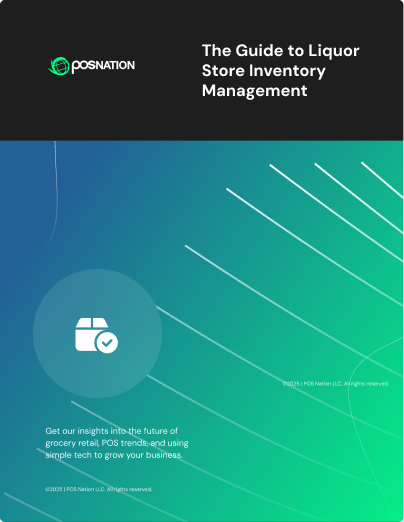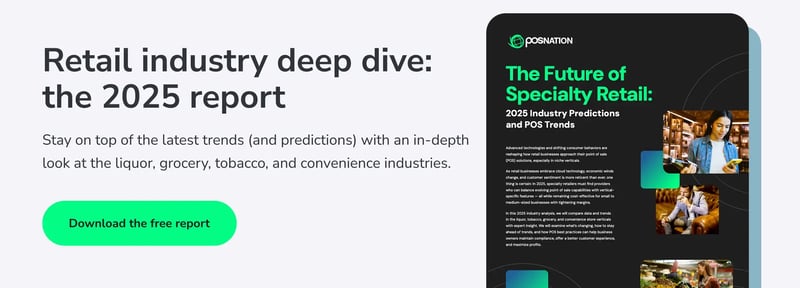American businessman and Camping World CEO Marcus Lemonis once said, “If you don’t know your numbers, you don’t know your business.”
Many convenience store owners are great at bringing in more sales, but are left scratching their heads when those sales don’t equal a boost in take-home pay. That’s where knowing your profit margins comes in handy.
Understanding convenience store profit margins is useful for everything from setting prices and merchandise planning to dialing in pitch-perfect promotions and marketing.
In this article, we’ll dissect all aspects of convenience store profit margins and how a good profit margin is relative. We’ll also dive into how you can improve your profit margin using your convenience store point of sale (POS) system.
Your Convenience Store Profit Margin: Why It Matters
Knowing your store’s profit margin is crucial. It tells you whether your store is making money, how efficient it is, and ultimately, what your profit will be as a store owner.
While some people’s eyes glaze over at the mention of “profit margin,” not knowing this number is risky. You won’t know if your store is making or losing money, and you won’t be able to forecast your available capital for future equipment purchases or store improvements.
Don’t make the mistake of only looking at total revenue! While it’s an important number, revenue hasn’t factored in all the costs of running your business — and it doesn’t tell you which specific products are contributing the most to your business’ success.
What Is Profit Margin? How To Calculate Yours
Before we go into tips for boosting your profit margin, let’s cover the basics. Profit margin compares the revenue you’re bringing in to the cost of running your business. It’s a profitability ratio used to gauge how well your business is doing financially.
It indicates how many cents of profit your business generates for each dollar you make. For example, if a business achieves a 22% profit margin in a quarter, it makes 35 cents for each dollar of sales.
Let’s dig in a little more.
Gross Profit
Gross profit is the profit a company makes after deducting the expenses involved with stocking the store (e.g. cost of inventory, delivery costs, and labor to stock shelves). To calculate gross profit, you subtract the cost of goods sold (COGS) from revenue (sales) made on the products or services sold.
Revenue – COGS = Gross Profit
Example: A small corner store earning $35,000 in monthly revenue spends a combined $25,000 on inventory, labor, and other costs. In that case, the store’s gross profit is $10,000.
Gross Profit Margin
Gross profit margin takes the gross profit figure (calculated above) and divides it by revenue to get a handle on the percentage of profit you’re earning after inventory costs. To put it another way, gross profit is a dollar amount, whereas gross profit margin is displayed as a percentage.
Gross Profit Margin = (Revenue – COGS) / Revenue
Example: The same company above that earned $10,000 in gross profit would be making a 33% gross profit margin ($10,000 / $30,000).
Net Income
Net income (also called net profit) is calculated as revenue (sales) minus the cost of goods sold and fixed costs such as selling, general and administrative expenses, operations, interest, and taxes. It’s often referred to as the bottom line on an income statement.
Net Income = Revenue – Total Expenses
Example: In addition to the $25,000 they spend on their goods, they also spend $8,000 a month on rent, labor, utilities, and other costs, bringing their total expenses to $32,000. That makes their monthly net income $2,000.
Net Profit Margin
Again, instead of a dollar amount, net profit margin is displayed as a percentage and measures how much income is generated as a percentage of revenues received.
Your net profit margin is a clear indication of whether your business is generating enough profit and whether operating costs and overheads are well-managed — that makes it one of the most crucial indicators of your store’s health.
Net Profit Margin = (Net Income / Total Revenue) x 100
Example: The corner store’s total monthly revenue is $35,000, and its net profit is $2,000. That makes its net profit margin 5.7%.
What Is a Good Convenience Store Profit Margin?
Convenience store profit margins are notoriously small, with most small stores achieving around a 5% profit margin. Larger chains with more brand recognition might get as high as 10%.
So, put simply, anything above a 5% net profit margin would be considered good for an independent c-store. That said, “good” is subjective. A good profit margin is one you can maintain or increase year over year.
This extra cash will help you plan for unexpected developments (both good and bad), like:
- Rising insurance, rent, and utilities costs
- Sudden dips in sales or supply chain disruptions
- Expanding into a new product line or working with a new supplier
- Opening a new location or hiring more employees
- Investing in new technology like self-checkout, ID scanners, or security cameras
Achieving a healthy profit margin is dependent on creating consistent processes that can grow with your business, understanding your customer base, and finding ways to work as efficiently as possible.
How To Improve Your Convenience Store Profit Margin
While many store owners are tempted to just look at total sales, net profit margins provide a more realistic picture of the overall financial health of your convenience store.
Think of it like this: Another store may be earning more than you on paper, but if you can negotiate better deals with your suppliers, reduce your inventory costs, or find other areas to reduce expenses, you may be taking home more money overall — and that extra money is crucial in the face of tariffs and rising costs.
There are three main ways to increase your profit margin:
- Reduce costs.
- Increase prices.
- Increase sales.
Let’s go into a bit more detail on all three points.
1. Reduce Inventory Costs
There are many ways to reduce costs, but let’s focus on the expense that’s highest for most convenience stores: inventory. Stocking your shelves isn’t cheap, and making sure you’re not overstocking or spending money on stock that won’t sell is crucial.
The first step in controlling your inventory costs is to use a modern inventory management system (if you aren’t already). These tools give you an accurate and real-time view of your stock levels, updating every time you receive stock or make a sale.
Here are a few things you can do to control your inventory costs:
- Use the sales data on your POS to negotiate better rates with suppliers. If you can objectively show that their products sell consistently, they’ll be more willing to work with you.
- Consolidate orders with trusted suppliers — a higher minimum order quantity (MOQ) will generally result in lower per-unit costs.
- Set low-stock alerts in your inventory management system for top sellers to avoid overordering or stockouts.
- Monitor inventory turnover rates to see if you’re over- or under-ordering certain items.
- Use shrinkage reports to spot and address losses due to spoilage or theft.
- Use sales data to identify seasonal trends and shifts in demand to adjust your ordering levels.
- Track expiration dates so you can discount soon-to-expire items and avoid a total loss.
While this isn’t an exhaustive list, it shows just why inventory data is vital for improving your stocking decisions, negotiating with suppliers, and finding other opportunities to cut costs.
Related Read: Retail Store Stock Management: 6 Best Practices, Tips, and Tools
2. Change Prices Strategically
When faced with cost increases from inflation or tariffs, it might be tempting to raise prices across the board. We don’t recommend it. A sudden increase in prices might be off-putting for customers and push them to shop somewhere else.
Instead, take a look at your sales data to price your products more strategically. Here are a few tips:
- Price your key value items (KVIs) like fountain drinks and popular bags of chips as competitively as possible — these popular items are how many people decide whether your brand is affordable or not.
- Look at profit margins on an item-by-item basis when making price increases.
- Monitor which items perform well when discounted and use them to create bundles or buy one, get one (BOGO) deals.
- See how sales of certain product categories change throughout the day to come up with time-sensitive discounts.
- See if there are product categories that people are willing to pay more for (e.g. craft beer) and stock more of these high-margin items.
The key takeaway is this: Don’t set prices based on gut feelings. Use the reports on your POS system to back up your intuition and, most importantly, monitor the effects of any price changes.
3. Increase Sales and Retain Customers
The final way to increase sales is through more sales — but as we all know, that can be easier said than done.
However, getting more sales isn’t the same as getting more customers. In fact, returning customers tend to spend more than new customers, making keeping the customers you already have a high priority.
Here are some tips to boost sales (and profits) at your convenience store:
- Set up a points program at your store to encourage repeat shoppers with discounts and perks.
- Segment your customers to send them relevant offers (e.g. send a BOGO chip offer to customers who bought chips in the last 2 weeks).
- Run regular deals and discounts to encourage repeat visits. Announce your sales with signage and a newsletter.
- Work with local businesses and suppliers to stock unique products to differentiate yourself from corporate chains.
- Create meal deals and other product bundles to upsell customers and increase average transaction size.
- Regularly post on social media to connect with customers, highlight unique products, and announce upcoming sales.
Remember to monitor the success of your various marketing strategies so you have an honest idea of what kinds of deals your customers connect with (and which ones are duds).
A Good Convenience Store Profit Margin: It’s Personal
A good convenience store profit margin is personal to you and your store. If you’re savvy, you can improve your margins by optimizing inventory and reducing expenses. A modern convenience store POS system can help as well by:
- Speeding up checkout
- Simplifying inventory management
- Providing the data to help you make growth-oriented decisions
To find the perfect POS system for your convenience store, talk with one of our experts today.







 by Cort Ouzts
by Cort Ouzts

 by Gina Obert
by Gina Obert
